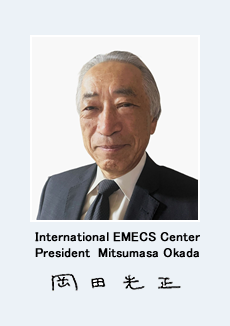Message from the President

Enclosed coastal seas are sea areas that are influenced not only by the open sea but also by land through human activities, etc. in coastal areas. They are, so to speak, sea areas where land and sea intersect. In the Seto Inland Sea, a representative example of an enclosed coastal sea, the quality of water was once so deteriorated that it was called a “dying sea,” and thus various effluent regulations, including TMDL (Total Maximum Daily Loadings), have been implemented. Under these circumstances, in 1994, the International EMECS Center was established with the aim of creating and preserving the environment not only in the Seto Inland Sea but also in other enclosed coastal seas throughout the world that were facing similar problems.
Since then, the quality of water in the Seto Inland Sea has been improved by effluent regulations and other measures. However, in recent years, biological productivity has stagnated, as evidenced by the decrease in fish catch and the deterioration of seaweed quality, and it is now believed that improvement of water quality alone will not restore the richness of the Seto Inland Sea as it once was. Therefore, the 2015 amendment to the Act on Special Measures concerning Conservation of the Environment of the Seto Inland Sea included a provision to “make the Seto Inland Sea a rich sea that maximizes its multifaceted value and functions, such as ensuring biological diversity and productivity,” and the 2021 amendment of the same act newly incorporated a special exception allowing measures to appropriately manage nutrient concentration in specific areas of the sea.
In the meanwhile, in 2023, the “National Biodiversity Strategy and Action Plan (2023 – 2030)” was established, setting a target to conserve at least 30% of the land and sea as healthy ecosystems (30 by 30), and it was decided to certify sea areas where sustainable human activities contribute to biodiversity conservation as Other Effective area-based Conservation Measures (OECMs).
In this way, environmental conservation of enclosed coastal seas has shifted from unilateral load reduction, as was the case when the Center was founded, to load management to restore biodiversity, and then to conservation of biodiversity in coastal ecosystems. Integrated coastal management and the creation of satoumi, which have been the focus of attention at recent EMECS Conferences and other events, are precisely in response to these changes.
To further promote these approaches, the Center is required more than ever to build an organic network among administrative bodies, researchers, businesses, citizens and other parties concerned and to promote international and academic exchanges. Your cooperation and support would be greatly appreciated.
January 2024


